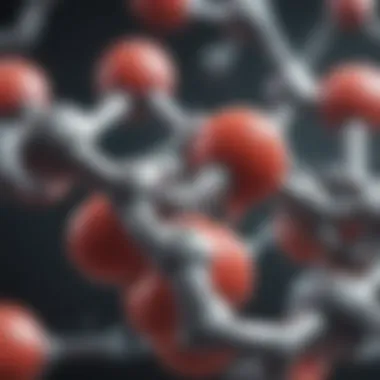Navigating the Link Between Statins and Gout Flare-Ups


Intro
The relationship between statins and gout flare-ups is an underexplored area in both pharmacology and rheumatology. Statins are primarily recognized for their role in lowering cholesterol levels, thus reducing cardiovascular disease risk. However, emerging evidence suggests that they may also influence uric acid levels in the body, raising questions about their potential to trigger gout flare-ups in susceptible individuals. In this article, we delve into the biochemical mechanisms behind this phenomenon, the existing research surrounding it, and how healthcare professionals can navigate these findings in clinical practice.
Prolusion to Statins and Gout
Understanding the relationship between statins and gout is essential for healthcare professionals and patients alike. Statins are mainly known for their role in managing cholesterol, but recent discussions suggest they may also impact uric acid levels, influencing the frequency and severity of gout flare-ups. This connection bears significance given that gout can severely affect a patient's quality of life.
Overview of Statins
Statins are a class of drugs widely prescribed to lower cholesterol levels in individuals at risk of cardiovascular diseases. Medications such as atorvastatin, simvastatin, and rosuvastatin belong in this category. They work by hindering the enzyme HMG-CoA reductase in the liver, a crucial step in cholesterol production. Beyond lipid-lowering properties, some evidence suggests statins may also possess anti-inflammatory effects. This aspect could potentially have implications on conditions characterized by inflammation, such as gout.
What is Gout?
Gout is a type of inflammatory arthritis caused by elevated levels of uric acid in the blood, leading to the formation of urate crystals in joints. This condition frequently presents as sudden and intense pain, often affecting the big toe. Patients may experience swelling, redness, and warmth in the affected areas. Understanding gout's pathology is vital, particularly in determining how concurrent conditions, like high cholesterol, may influence its recurrence.
Understanding Uric Acid
Uric acid is a waste product formed when the body breaks down purines, substances found in certain foods and drinks. Under normal circumstances, the kidneys effectively eliminate uric acid through urine. However, when production exceeds removal, hyperuricemia occurs, setting the stage for gout. The interplay between uric acid levels, dietary habits, and the use of certain medications like statins becomes key in managing gout effectively.
Mechanisms Behind Statins
Understanding the mechanisms by which statins operate is crucial in evaluating their potential role in gout flare-ups. Statins primarily function to lower cholesterol levels in the body, but their impact on metabolism and inflammation may extend beyond lipid management. This insight is significant, particularly for healthcare professionals managing patients with conditions like gout, as it may offer pathways to better treatment strategies.
How Statins Work
Statins inhibit the enzyme HMG-CoA reductase, which is essential in the cholesterol synthesis pathway. This reduction in cholesterol synthesis not only lowers low-density lipoprotein (LDL) levels but also prompts a cascade of physiological events. By decreasing cholesterol production, statins can improve endothelial function, reduce inflammation, and stabilize atherosclerotic plaques. However, this mechanism can create implications for uric acid metabolism, contributing to an increase in gout flare-ups.
Most statins are well-tolerated, but they do have a varied impact on different populations. The biochemical pathways are complex, and the degree of efficacy often varies by individual. The exploration of how precisely statins influence uric acid levels warrants attention, particularly as treatment strategies evolve.
Effects on Lipid Profiles
Statins are known to effectively reduce total cholesterol and, specifically, harmful LDL cholesterol. This is achieved through their mechanism of action, primarily targeting the liver where most cholesterol is produced.
- Reduction of LDL: Statins significantly lower LDL cholesterol, a primary target for cardiovascular risk reduction.
- Increase of HDL: Some statins may slightly raise high-density lipoprotein (HDL) levels, often referred to as "good cholesterol."
- Decreased Triglycerides: Statins also contribute to lowering blood triglyceride levels, another lipid that can pose health risks when elevated.
While these factors are beneficial for cardiovascular health, their relationship with gout remains complex. The mechanisms by which statins alter lipid profiles might indirectly affect uric acid levels, leading to an increased risk of gout flare-ups.
Gout Pathophysiology
Understanding gout pathophysiology is crucial for grasping the intricacies of how statins might affect gout flare-ups. Gout is a form of inflammatory arthritis characterized by sudden and severe pain, redness, and swelling in the joints. The underlying cause of this condition is closely related to elevated uric acid levels in the blood, leading to the formation of monosodium urate crystals. These crystals can accumulate in joint spaces, triggering intense inflammatory responses.
The focus on gout pathophysiology allows for a clearer insight into how medications such as statins may interplay with uric acid metabolism. Proper knowledge can enhance treatment strategies and guide healthcare providers in managing patients who may be taking statins while also suffering from gout.
Causes of Gout Flare-Ups


Gout flare-ups may be induced by a variety of factors. Some of the most significant causes include:
- Dietary Choices: Consuming foods high in purines, such as red meats, fatty fish, and alcohol, can increase uric acid levels.
- Dehydration: Insufficient fluid intake can lead to higher concentrations of uric acid in the blood.
- Medications: Certain diuretics and drugs affect uric acid excretion, potentially exacerbating gout symptoms.
- Injury or Stress: Physical trauma or stress can also trigger a flare-up by inducing inflammatory responses.
- Obesity: Increased body weight can lead to higher production and lower excretion of uric acid.
Each of these factors contributes to the chemical environment that promotes crystal formation in joints. Understanding these can help healthcare providers to counsel patients on lifestyle modifications to mitigate flare-ups effectively.
Hyperuricemia and Its Role
Hyperuricemia refers to the condition of having excess uric acid in the bloodstream. It is regarded as a key player in the development of gout. When the kidneys are unable to adequately filter uric acid, or when purine metabolism results in an overproduction of uric acid, hyperuricemia occurs, setting the stage for gout flare-ups.
Importantly, not everyone with hyperuricemia will develop gout. The risk factors, such as family history and metabolic conditions, play a significant role in this transition. The concentration of uric acid is what ultimately determines whether or not crystals form. Therefore, addressing hyperuricemia is essential in managing gout effectively.
"Managing uric acid levels is fundamental in the prevention of gout flare-ups."
Through regular monitoring and lifestyle management, patients can significantly influence their uric acid levels, although the role of statins in uric acid modulation remains a topic of ongoing research. Addressing hyperuricemia not only helps in controlling gout but may also have implications for cardiovascular health, particularly for patients on statin therapy.
Potential Influence of Statins on Uric Acid Levels
The relationship between statins and uric acid levels is an area of growing interest. Statins are primarily used to manage cholesterol levels, but their effects on other metabolic processes warrant investigation. One significant topic is their potential influence on uric acid levels in the body. This matters for patients who suffer from both high cholesterol and gout, as these conditions can intersect complicating treatment plans. Understanding this interplay helps healthcare providers tailor strategies that can prevent gout flare-ups in patients on statin therapy.
Statins and Uric Acid Metabolism
Statins may affect uric acid metabolism through various biochemical pathways. They work primarily by inhibiting the HMG-CoA reductase enzyme, which is critical for cholesterol synthesis. Some studies propose that this mechanism can indirectly influence uric acid levels.
- Inhibition of Uric Acid Production: Statins may decrease the production of uric acid by influencing certain hepatic pathways, thereby reducing the overall uric acid pool in the body.
- Enhancement of Renal Excretion: There is evidence suggesting that statins might enhance the renal clearance of uric acid, which would help lower the serum uric acid levels.
Research indicates that this variable may lead to differing levels of uric acid among patients on statins. Since hyperuricemia is a key risk factor for gout, the impact of statins on uric acid is particularly relevant for practitioners.
Clinical Observations
Clinical observations have brought to light some important insights regarding statins and gout. While studies show a correlation between statin use and reduced gout impacts, results are mixed.
- Gout Incidence Reduction: Some observational studies show that patients using statins have a lower incidence of gout flare-ups, suggesting a potential protective effect.
- Variability in Responses: Other studies indicate variability, with some patients experiencing gout rather than experiencing fewer incidents. This inconsistency complicates the clinical picture.
Ultimately, the effects of statins on gout are not uniform, warranting careful observation and personalized treatment approaches. Understanding these nuances allows healthcare providers to better manage patient care and mitigate risks associated with uric acid fluctuations.
Review of Scientific Literature
The exploration of scientific literature regarding the connection between statins and gout flare-ups is critical for understanding the potential associations and implications of these two health conditions. This section consolidates diverse studies and findings, offering a comprehensive analysis of how statin medications might influence gout, a form of inflammatory arthritis.
Importance of Literature Review
A literature review serves as a scaffold for any research, providing context and clarity. It enables healthcare providers, medical researchers, and students to grasp the present knowledge landscape surrounding statins and gout. By assessing various studies, one gains insight into different methodologies, sample populations, and outcomes related to both statin use and gout occurrences.
Additionally, this process highlights gaps where further research is needed. Recognizing these areas can steer future studies to explore unanswered questions, ultimately improving patient care. This literature review not only informs clinical practice but also enhances our understanding of biochemical interactions at play.
"A thorough literature review enables a systematic approach to understanding the complexities of medical interactions, empowering healthcare professionals with the knowledge needed for informed decision-making."
Studies Linking Statins and Gout


Multiple studies have examined the potential link between statins and gout flare-ups. These investigations often focus on how statins, known primarily for their lipid-lowering effects, may also impact uric acid levels. One pivotal study revealed a correlation between statin usage and reduced rates of gout flare-ups, suggesting that statins not only manage cholesterol but might also aid in uric acid regulation.
However, results are mixed. Some large cohort studies suggest that statin therapy does not significantly alter uric acid levels or reduce the frequency of gout episodes. Other studies indicate a nominal reduction in gout flare-ups among statin users compared to those not on statins. These differing results prompt careful examination of the study designs, patient demographics, and statin types used in research.
Overall, while there's a noteworthy amount of data, further analysis is warranted to solidify our understanding of the connection between statins and gout.
Variability in Results
The variability in research results on statins and gout presents crucial insights for both clinical practice and future research. Studies yield inconsistent conclusions, making it difficult to draw definitive links or establish a consensus. Factors contributing to this variability include:
- Population Diversity: Studies involve different patient demographics, including age, sex, and varying severity of both hyperlipidemia and gout. These differences can influence outcomes significantly.
- Types of Statins: Different statin medications, such as Atorvastatin or Rosuvastatin, may have distinctive effects on uric acid levels. Variations in pharmacodynamics could explain divergent findings.
- Study Design: Many studies have different methodological frameworks. Some are observational, while others incorporate randomized controlled trials. This variation can lead to disparate conclusions.
Researchers must take these factors into account when interpreting results. The inconsistency highlights the need for more robust and comprehensive studies to pinpoint the nature of the relationship between statins and gout flare-ups. Identifying clear patterns could assist healthcare professionals in making informed decisions regarding patient management.
Patient Case Studies
Patient case studies play a crucial role in understanding the intricate relationship between statins and gout flare-ups. They provide real-world context and insights that can sometimes be overlooked in clinical trials and lab studies. By examining individual patient experiences, healthcare professionals can identify patterns and correlations that contribute to a deeper understanding of the potential side effects of statins on gout incidents.
These case studies allow for the exploration of various factors such as patient history, lifestyle choices, and co-existing medical conditions that may influence both statin usage and the frequency of gout attacks. This personalized approach can unveil underlying mechanisms that statistical analyses might miss, leading to more tailored treatment strategies. The insights gleaned from documented cases aid in refining clinical guidelines and optimizing patient management.
Documented Cases of Gout Flare-Ups
Several documented cases highlight the connection between statin use and gout flare-ups. For instance, there are reports of patients who were prescribed atorvastatin or simvastatin, only to experience increased frequency and severity of gout attacks. In some of these cases, patients had a pre-existing history of gout, while others developed symptoms for the first time after starting statin therapy.
The doses of statins seem to play a role as well. Patients taking high doses reported more frequent flare-ups compared to those on lower doses. Additionally, individuals with certain risk factors, such as obesity or a diet high in purines, may have heightened susceptibility to these gout flare-ups when on statins.
Examining Correlation and Causation
Understanding the distinction between correlation and causation is vital when examining the relationship between statins and gout. Just because two events occur concurrently does not mean one causes the other. Some researchers have suggested that statin use might simply coincide with other lifestyle changes that contribute to gout incidents, such as dietary changes or weight fluctuations.
To accurately assess causation, longitudinal studies and controlled clinical trials are essential. These research designs can offer more robust data on how statins may directly affect uric acid levels and, in turn, influence gout flare-ups. While some studies have indicated a causal link, more data is needed to establish a clear, definitive relationship.
Case studies contribute to this understanding by providing specific examples where a clear timeline is established. Clinicians can analyze the sequence of events—statin initiation followed by gout symptoms—to assess possible causation within individual patients. This type of evaluation is crucial for guiding treatment decisions and informing patients about potential risks.
"Patient case studies are invaluable for understanding nuanced interactions in clinical medicine. They help bridge the gap between research findings and real-world practices."
Overall, while patient case studies suggest a complex interplay between statin use and gout flare-ups, careful examination and further research are needed to definitively determine causation. These insights are essential for patient education and developing more effective management strategies.
Clinical Implications for Healthcare Providers
The relationship between statins and gout flare-ups carries significant implications for healthcare providers. Understanding this connection is crucial for optimizing patient care and ensuring that individuals receiving statin therapy are adequately monitored for signs of gout. Statins are widely prescribed to manage cholesterol levels; however, their influence on uric acid levels can complicate treatment goals.
Practitioners need to be aware of the possibility that statin use may affect the frequency and severity of gout attacks. Effective patient management involves recognizing risk factors and implementing appropriate monitoring strategies. Continuous assessment of uric acid levels in patients taking statins is recommended to prevent potential complications related to hyperuricemia.
Monitoring Patients on Statins


Monitoring is essential for patients on statin medications. Healthcare providers should regularly evaluate uric acid levels, especially in individuals with a history of gout or hyperuricemia. This proactive approach allows for early detection of elevated uric acid levels, which may precipitate gout flare-ups.
Key considerations include:
- Baseline Evaluation: Prior to initiating statin therapy, obtain a baseline uric acid level to establish a reference point.
- Regular Testing: Schedule periodic uric acid level tests to monitor fluctuations during statin use. This can help identify any trends toward increased levels.
- Symptoms Tracking: Educate patients on recognizing signs of gout flare-ups, such as sudden joint pain and swelling.
- Collaborative Care: Promote communication with specialists, such as rheumatologists, for patients experiencing recurrent gout episodes while on statins.
Strategies to Manage Gout Episodes
When managing gout episodes in patients taking statins, healthcare providers should consider a comprehensive strategy. The goal is to mitigate acute flare-ups while continuing necessary cholesterol management.
Effective management strategies can include:
- Medication Review: Regularly assess all medications the patient is taking, including non-steroidal anti-inflammatory drugs (NSAIDs), to avoid interactions and enhance efficacy.
- Dietary Counseling: Advise patients on lifestyle modifications such as reducing purine-rich foods that may exacerbate uric acid production. This can include limiting red meat, seafood, and beverages sweetened with fructose.
- Hydration Encouragement: Encourage adequate fluid intake to help facilitate the excretion of uric acid.
- Consider Adjunct Therapies: In certain cases, prescribing medications specifically for gout management, such as allopurinol or colchicine, may be beneficial alongside statins.
Optimizing patient care necessitates a comprehensive approach that includes monitoring and proactive management strategies for patients on statins.
In summary, the connection between statins and gout flare-ups underscores the need for vigilant monitoring and tailored management strategies by healthcare providers. By implementing proactive measures, clinicians can enhance patient outcomes and minimize complications from both conditions.
Recommendations for Future Research
Research on the relationship between statins and gout flare-ups is essential for advancing understanding in this area. The current body of literature presents a complex picture, with many studies showing variable results. Identifying the nuances in these findings can aid in developing clearer guidelines for both healthcare providers and patients.
Identifying Knowledge Gaps
A significant aspect of future research involves pinpointing the existing knowledge gaps in the current literature. Some of these gaps may include the following:
- Longitudinal Studies: Most existing studies are cross-sectional. Longitudinal studies can track changes in uric acid levels and gout episodes over time in patients taking statins.
- Diversity in Patient Populations: Many studies do not consider the variability in demographic factors, such as age, sex, and race, which could influence results. Immediate attention on diverse cohorts is necessary.
- Mechanistic Insights: More research is needed to delineate the precise biochemical pathways through which statins may affect uric acid levels. This includes understanding the various subtypes of statins and their respective impacts.
Filling these gaps could provide a more nuanced understanding and clearer guidance for practitioners.
Potential Research Directions
To advance the field, several potential research directions can be pursued:
- Clinical Trials: Well-designed randomized clinical trials can be conducted to assess the effects of various statins on uric acid levels and gout incidence. This could lead to evidence-based recommendations for patient care.
- Pharmacogenomic Studies: Exploring genetic factors that may influence the efficacy and impact of statins on gout might uncover why some patients experience flare-ups while others do not.
- Comparative Effectiveness Research: Comparing the effects of different classes of lipid-lowering agents on gout could identify alternatives for patients susceptible to flare-ups while on statin therapy.
- Patient-Reported Outcomes: Integrating patient-reported outcomes into future studies can help illuminate the real-world impact of statin therapy on quality of life in gout patients.
By directing attention towards these areas, we can potentially reshape the understanding of statins' role in gout management, ultimately leading to better care and improved outcomes for patients.
Culmination
The conclusion section of this article plays a pivotal role in synthesizing the insights gathered throughout the examination of statins and gout flare-ups. Understanding the relationship between statins, cholesterol management, and gout is not only crucial for patient care but also for advancing clinical practice.
Summary of Findings
This article reviewed the connection between statin use and the risk of gout flare-ups. Studies indicated varied results regarding statins' influence on uric acid levels, leading to debates within the medical community. Some findings suggest that certain statins might actually lower uric acid, while others indicate an increase in gout episodes. These mixed results highlight a significant gap in the knowledge base surrounding this topic. Given the complexities, healthcare providers must be vigilant when prescribing statins to patients with a history of gout. Regular monitoring of uric acid levels should be considered to mitigate the risk of flare-ups.
Final Thoughts
As we finalize our exploration into statins and gout, it is essential to recognize the importance of continued research. Further studies are necessary to better understand the biochemical link and the implications for treatment protocols. This understanding is critical not just for the individual patient but also for broader public health insights. Informed patient care can lead to better outcomes, which is ultimately the goal of any medical intervention. By recognizing the potential influence of statins on gout flare-ups, clinicians can refine their treatment approaches, thereby enhancing the quality of life for patients affected by these conditions.
"A careful and nuanced understanding of the connection between statins and gout is essential for effective patient management."
Future investigations should focus on clarifying the underlying mechanisms and identifying specific patient populations at risk. This could pave the way for tailored therapeutic strategies, emphasizing the significance of an interdisciplinary approach in handling such complex health issues.



